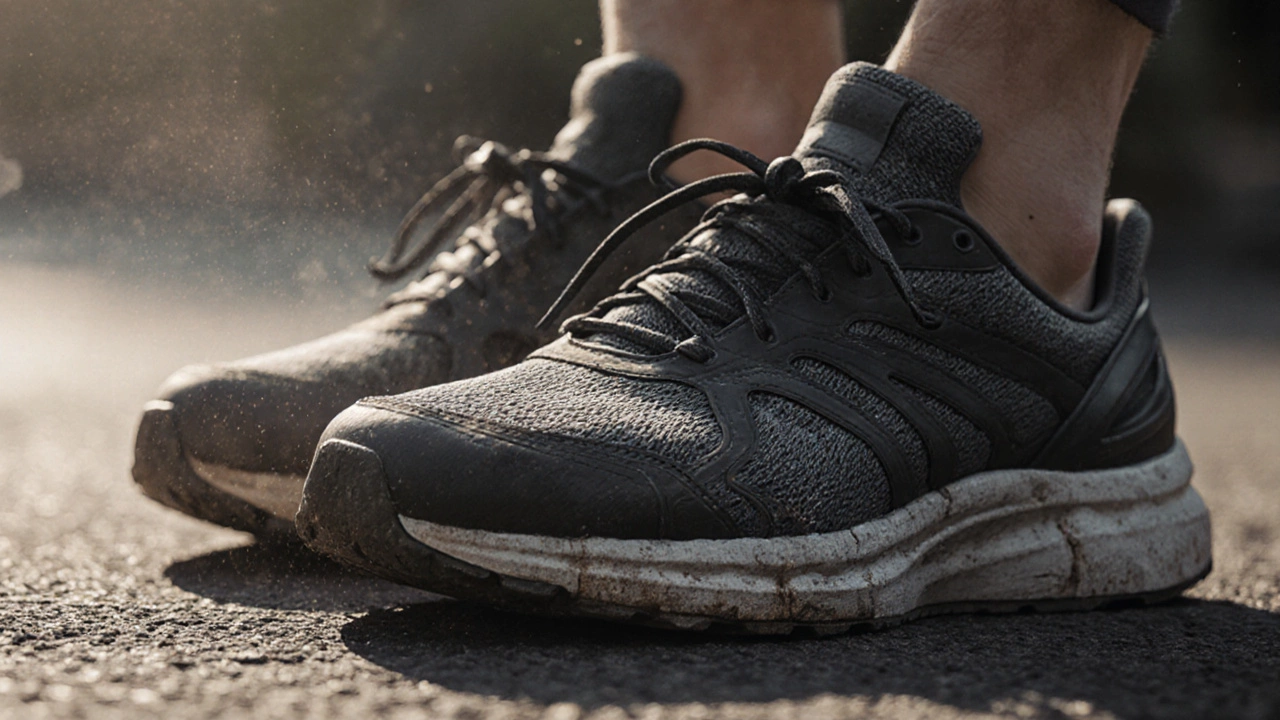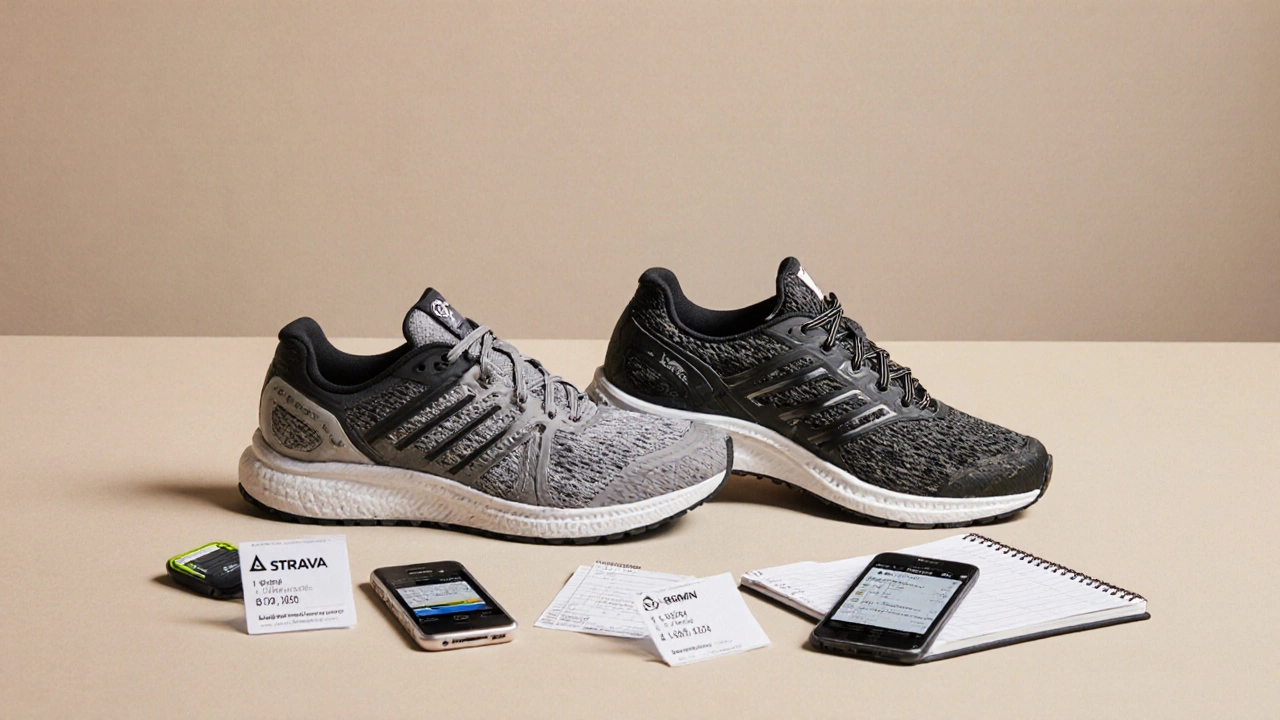How Do I Know When I Need a New Pair of Running Shoes?
 Nov, 27 2025
Nov, 27 2025
Running Shoe Replacement Calculator
Find out when your running shoes need replacing based on your mileage and running conditions.
Signs Your Shoes Need Replacing
Remember: The midsole is what protects your body. When it's gone, no amount of stitching or glue will help.
You lace up your running shoes every morning, hit the pavement, and keep going-until one day, your knees start aching, your feet feel flat, or your shoes just don’t feel right anymore. That’s not just in your head. Your running shoes are probably done.
Running shoes don’t last forever
Most runners think their shoes last as long as they look good. But the truth is, the cushioning and support break down long before the outsole wears thin. A pair of running shoes typically lasts between 500 and 800 kilometers. That’s about 3 to 6 months for someone running 20 kilometers a week. If you’re logging more than that, you’re pushing past their limit.
It’s not about how old they are-it’s about how much use they’ve had. A 6-month-old pair that’s only been worn 200 kilometers might still be fine. A 3-month-old pair that’s been used for 700 kilometers? Time to replace them.
Signs your running shoes are worn out
Here are the five most common signs you’re running in dead shoes:
- Your joints hurt more than usual - If your knees, hips, or lower back feel stiffer or more sore after runs, your shoes aren’t absorbing shock like they used to. Your body is taking the hit instead.
- The midsole looks compressed - Look at the side of your shoe. The foam should spring back when you press it. If it stays flat, or if you can see deep creases or wrinkles in the foam, the cushioning is gone.
- The tread is worn flat on one side - If the outsole is smooth on the heel or the ball of your foot, or if the shoe leans to one side when placed on a flat surface, your gait has changed because the support is gone.
- You feel every crack in the pavement - Remember how soft your shoes felt when they were new? If you’re now feeling every rock, curb, or patch of concrete, the midsole foam has lost its bounce.
- Your feet feel tired faster - If you’re getting foot fatigue earlier in your run than you used to, or if your arches feel unsupported, your shoes aren’t giving you the structure you need.
One runner in Sydney told me she switched shoes after a 10K race where her arches cramped up halfway through. She’d been running in the same pair for 18 months. They looked fine. But the foam had turned to mush. After switching, her pain vanished in two weeks.
How to track your shoe mileage
You don’t need to guess. Track your mileage like you track your pace.
- Use a running app like Strava, Garmin Connect, or Nike Run Club. Most automatically log distance per pair if you name your shoes.
- Write it down. Keep a simple notebook or spreadsheet. Note the date you started using the shoes and update it after every run.
- Set a reminder. When you hit 500 kilometers, start checking your shoes weekly. That’s when wear becomes critical.
Some runners keep two pairs and rotate them. That extends the life of each pair because the foam has time to recover between runs. It’s a small habit that adds months to your shoe life.

Don’t wait for holes to appear
A lot of people wait until the outsole is worn through or the upper is fraying. That’s too late. The midsole is the heart of your shoe. It’s the part that protects your body. Once it’s gone, no amount of stitching or glue will help.
Even if the outside looks perfect, the inside is what matters. If your shoes feel flat, stiff, or unresponsive, they’re not doing their job. Running in dead shoes increases your risk of plantar fasciitis, shin splints, stress fractures, and IT band syndrome. You’re not saving money-you’re risking injury.
What to look for in a replacement
When it’s time to buy new shoes, don’t just grab the same model because it’s familiar. Your body changes. Your running style changes. Your weight changes. So should your shoes.
- Get fitted at a specialty running store. Staff there can watch you run on a treadmill and recommend shoes based on your arch type and stride.
- Bring your old pair. They’ll check the wear pattern and know what kind of support you need.
- Try on shoes at the end of the day. Your feet swell during the day. That’s when they’re biggest.
- Leave a thumb’s width of space at the front. Your toes need room to spread, especially on long runs.
Don’t assume a bigger brand means better. Some of the most durable, supportive shoes come from smaller brands like Hoka, Altra, or Brooks. What matters is how they feel on your feet-not the logo.

What to do with old running shoes
Don’t toss them in the bin. Most running shoes can be recycled.
- Drop them off at a local running store that takes old shoes for recycling. In Sydney, stores like Runner’s High and Running Room have collection bins.
- Send them to programs like Nike’s Reuse-a-Shoe or Soles4Souls. They turn old soles into playground surfaces, tracks, or new footwear for people in need.
- If they’re still wearable for walking, give them to a friend, a charity, or a local gym.
There’s no shame in retiring your shoes. They’ve done their job. Now it’s time to give your body the support it deserves.
How often should you really replace them?
Here’s a simple rule: Replace your running shoes every 500-800 kilometers-or every 6 months if you run 3-4 times a week. If you’re heavier, run on hard surfaces like concrete, or have a heavy heel strike, lean toward the lower end of that range.
And if you’re unsure? Test them. Put your old pair on a flat surface. If they lean to one side, or if the heel doesn’t sit flat, they’re done. No need to overthink it.
Your body doesn’t lie. If your runs feel harder, your joints ache, or your shoes feel like bricks-listen. It’s not laziness. It’s physics. Cushioning wears out. Support fades. And your feet deserve better than that.
How many kilometers do running shoes last?
Most running shoes last between 500 and 800 kilometers. That’s about 3 to 6 months for someone running 20 kilometers a week. Heavier runners, those who run on concrete, or people with a strong heel strike may need to replace them closer to 500 kilometers.
Can I still run in shoes with worn-out soles?
You can, but you shouldn’t. Worn-out soles mean the midsole cushioning is already gone. Running in them increases your risk of injuries like plantar fasciitis, shin splints, and stress fractures. The outsole is just the bottom layer-it’s the foam inside that protects your body.
Should I buy the same model again?
Not necessarily. Your body changes over time-your weight, stride, or foot arch might shift. Always get fitted at a running store. Bring your old shoes so they can check the wear pattern. What worked last year might not be right now.
Do running shoes expire if I don’t use them?
Yes. Foam degrades over time, even if unused. Most manufacturers recommend replacing shoes after 2 to 3 years, regardless of mileage. If you bought a pair on sale two years ago and never wore them, they’re probably not giving you the support you think they are.
Is it worth buying expensive running shoes?
Not always. Price doesn’t guarantee performance. Some $150 shoes offer less support than $80 models. What matters is fit, cushioning, and how they feel when you run. Try them on, run in them, and listen to your body. The best shoe is the one that feels right-not the most expensive one.